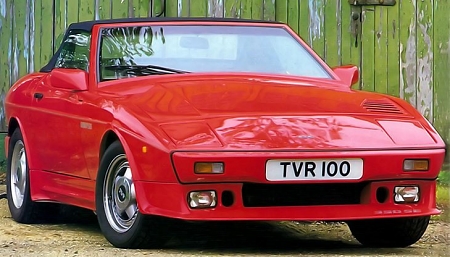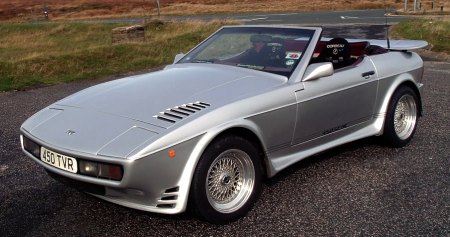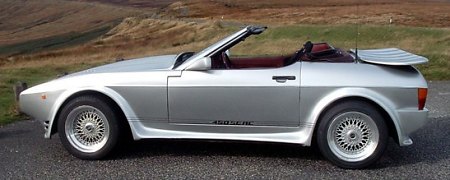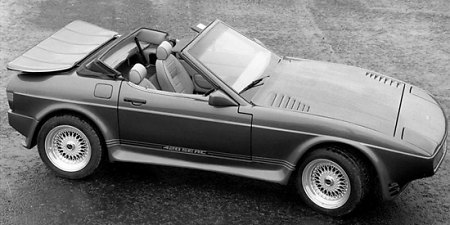 Amagingly, TVR had been
building much the same looking cars for 2 decades since the 1958 Grantura. However, the world had changed a
lot during the period. Lamborghini Countach and Lotus Esprit
kickstarted a new wave of space-age styling theme. By the late 1970s,
it became harder and harder for the classical TVRs to find admirers. In
1980, TVR finally retired the M-series and replaced it with a striking
new car called Tasmin. Its fashionable wedge
shape was designed by ex-Lotus designer Oliver Winterbottom, no wonder
it looked so close to Lotus Eclat/Excel. Unfortunately, the exotic look
was not matched by the underpowered Ford 2.8-liter V6 engine, so the
car did not impress contemporary motoring writers very much.
In 1983, TVR responded to the criticism by putting Rover SD1 Vitesse' 3.5-liter pushrod V8 into the Tasmin and transformed the car to 350i. This engine initially produced 190 horsepower (197 hp from 1985) and a wide spread of torque that peaked at 220 lbft. Its smoothness and flexibility improved the driving experience dramatically. Performance was lifted to the level of Lotus Esprit S3 and Porsche 924 Turbo – 140 mph top speed and 0-60 mph in 6 and a half seconds – while the car cost considerably less to buy. A niche market place was found.  The 350i was also praised for a good chassis. Like the
preceding M-series, it employed a multi-tubular backbone chassis, but
it was stronger and had a 4-inch longer wheelbase. The front
double-wishbone suspensions were largely derived from Ford Cortina,
while the rear looked like a crossover between Jaguar and Lotus, with
lower transverse links, a longitudinal radius arm and the drive shaft
acting as upper link at each side. The gearbox and differential came
from Rover and Jaguar respectively, while the steering again from Ford.
British magazines praised the chassis for good rigidity, roadholding,
poise, accurate steering and easy balance on throttle. On the downside,
the steering kickbacked heavily on rough roads, and the ride was hard
and jiggling on broken surfaces, which were not much of a surprise for
a TVR. More surprising was the cabin, which looked fairly luxurious
with polished wooden fascia, leather upholstery and comfortable seats.
The manual soft top was also quite well engineered, being simple and
easy to operate. Little buffeting
was found at speed up to 110 mph. As a result, most customers opted for
the roadster thus the liftback coupe died early. The 350i couldn't
match Porsche for build quality and attention to details, of course,
but it offered good performance and supercar styling for less money.
 That was just the beginning. Next year, TVR introduced 390SE as the higher performance derivative. The stock Rover V8 was bored out to 3905 cc and fitted with lightweight Cosworth pistons, high-lift camshaft, higher compression ratio, lighter flywheel and free-flowing exhaust, lifting output dramatically to 275 hp and 270 lbft. Even though these numbers might be optimistic, its performance still gave Porsche 911 Carrera a serious run for the money. Meanwhile, the rear suspension was heavily modified to improve body control, while 225/50VR15 tires replaced 205/60VR15 to offer more grip. In 1988, the engine was enlarged slightly to 3948 cc and the car became 400SE.  Even more exotic was the 420SEAC – its name stands for Special Equipment Aramid Composite. The body shell was constructed by the combination of Kevlar and carbon-fiber, saving a claimed 90 kg. The front overhang was shortened and restyled, flared wheel arches and skirts were added, as was a strange rear spoiler. The V8 was bored and stroked to 4228 cc, thanks to larger Cosworth pistons and a one-piece steel crankshaft. Output was claimed at 300 hp and 290 lbft, this time more credible because Fast Lane magazine recorded 0-60 and 0-100 mph in a 911 Turbo-beating 4.7 and 12.3 seconds respectively, even though the claimed 165 mph top speed was never verified. Being very powerful and lightweight simultaneously, the 420SEAC recalled our memory of the classic Griffith / Tuscan in the 1960s. Better still, it retained the fine drivability and usability of the regular 350i and 390SE. The only drawback was a harsh ride, blamed to the stiffer springs and inadequate damping. However, its £30,000 price tag – double of the 350i and equivalent to 911 Carrera – was probably too much for a TVR, so the car was extremely rare.  Even rarer was the 450SEAC. Basically the same as 420SEAC, but the engine was bored and stroked to 4441 cc, giving 324 hp and 310 lbft. It should be slightly quicker than the old car, although no media was offered the chance to test it. The so-called "Wedge series" lived until 1991, when it was replaced with new Griffith and Chimaera. It would be remembered as one of the symbols of the 1980s British sports cars. In total, 2618 cars were built, among them 1390 units were equipped with V8.  |